Facial Implants
Facial Implants Specialist
Dr. Barry Eppley has extensive experience helping plastic surgery patients with facial reconstruction and aesthetic needs with the use of facial implants. Dr. Eppley has compiled an extensive amount of information about this procedure and encourages patients to visit the facial implants results page to learn more.
Facial Implant Concepts
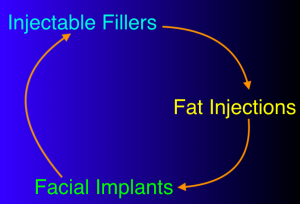 Facial augmentation with synthetic implants, while a part of facial plastic surgery for half a century, has become a more dynamic part of the specialty in the past decade. Driven by the increasing use of injectable fillers and autologous fat grafting, the need for longer-term solutions through facial implants has achieved a more prominent role in both facial reshaping and facial rejuvenation surgery. Today efforts at facial voluminization is much like a circle consisting of synthetic fillers, injectable fat and implants. Patients may enter and leave the treatment circle at any one of these three portals. Some patients may try synthetic fillers first and then graduate to implants for a more permanent result. Others may just jump immediately into implants. While some may even have implants removed and work with fillers and fat injections after.
Facial augmentation with synthetic implants, while a part of facial plastic surgery for half a century, has become a more dynamic part of the specialty in the past decade. Driven by the increasing use of injectable fillers and autologous fat grafting, the need for longer-term solutions through facial implants has achieved a more prominent role in both facial reshaping and facial rejuvenation surgery. Today efforts at facial voluminization is much like a circle consisting of synthetic fillers, injectable fat and implants. Patients may enter and leave the treatment circle at any one of these three portals. Some patients may try synthetic fillers first and then graduate to implants for a more permanent result. Others may just jump immediately into implants. While some may even have implants removed and work with fillers and fat injections after.
While these three facial augmentation methods are often used, and occasionally even in the same patient at different points in time, their outcomes are not always interchangeable. In the use of injectable techniques the primary effect is achieved through facial soft tissue expansion. Conversely, facial implants augment mainly the facial bones creating contours and convexities not always achievable with the use of injectable materials. This concept is exemplified when either approach is overdone…injectable materials create a rounder overblown facial look while implants create an enlarged skeletonized facial appearance.
Facial Implant Materials
Before choosing implant styles and sizes, every patient must first consider the implant material of choice. This is a topic that is rife with opinions about the ideal or best material from surgeons and patients alike…often based on inaccurate information and lacking in the basic science and biology of facial implant materials. The reality is that there is no best facial implant material that has all the favorable properties desired. The ideal facial implant material properties include being biologically inert, non-biodegradable, resistant to infection, available in all the desired shapes and sizes, easily shaped and inserted, above to maintain its form and position and be cost effective. No such facial implant material has all of these properties. Surgeons often have strong preferences largely because they may have limited familiarity with the entire spectrum of facial implants commercially available. Thus it is important to look at the three basic facial implant materials most commonly used with their advantages and disadvantages and develop a preference based on their dimensional capabilities and handling properties.
Silicone
![]() Solid silicone facial implants make up the majority of facial augmentations done today. They have been around the longest of all the materials with a well known history of clinical use. Their advantages are the largest selection of implants styles and sizes by far, ease of insertion through the smallest incisions, ability to be easily modified during surgery, a low infection rate with a smooth surface which discourages bacterial adhesion, ability to be removed in an atraumatic fashion and relatively low implant cost. Their disadvantages are lack of immediate adherence to the implantation site (unless secured with screws) and lack of tissue ingrowth. (which may or may not be disadvantage)
Solid silicone facial implants make up the majority of facial augmentations done today. They have been around the longest of all the materials with a well known history of clinical use. Their advantages are the largest selection of implants styles and sizes by far, ease of insertion through the smallest incisions, ability to be easily modified during surgery, a low infection rate with a smooth surface which discourages bacterial adhesion, ability to be removed in an atraumatic fashion and relatively low implant cost. Their disadvantages are lack of immediate adherence to the implantation site (unless secured with screws) and lack of tissue ingrowth. (which may or may not be disadvantage)
Porous Polyethylene
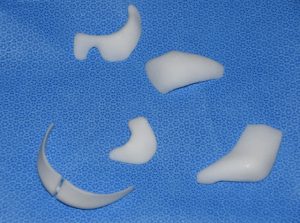 Porous polyethylene, more commonly known as Medpor and now also Omnipore, is best known because it gets significant tissue adherence into it. It is a very hard and non-compressible polymer The implant surface has pores measuring 100 to 300 microns which is why tissue ingrowth occurs. This constitutes its main advantage which virtually eliminates any risk of implant migration and movement to any amount of exposed external forces later. It only has a modest amount of implant selections for the chin, jaw angles, cheeks and orbital rims. Its disadvantages are a slightly increased risk of infection (which all porous implants materials have), larger incisions needed for placement due to the stiffer material, more difficult to intraoperatively modify (but not impossible), need for multiple screw fixation to get the material more adapted to the bone and the the significant tissue ingrowth should revision or removal be necessary.
Porous polyethylene, more commonly known as Medpor and now also Omnipore, is best known because it gets significant tissue adherence into it. It is a very hard and non-compressible polymer The implant surface has pores measuring 100 to 300 microns which is why tissue ingrowth occurs. This constitutes its main advantage which virtually eliminates any risk of implant migration and movement to any amount of exposed external forces later. It only has a modest amount of implant selections for the chin, jaw angles, cheeks and orbital rims. Its disadvantages are a slightly increased risk of infection (which all porous implants materials have), larger incisions needed for placement due to the stiffer material, more difficult to intraoperatively modify (but not impossible), need for multiple screw fixation to get the material more adapted to the bone and the the significant tissue ingrowth should revision or removal be necessary.
ePTFE
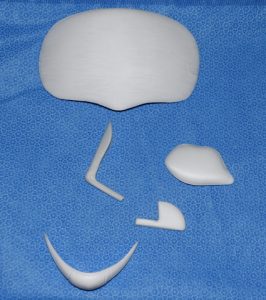 Expanded polytetrafluorethylene (ePTFE) has been used in aesthetic facial surgery since the late 1980s and is historically known as Gore-tex or SAM. (subcutaneous augmentation material) PTFE is very similar to Teflon and ePTFE is a softer version of it that is widely used in many medical implants. (e.g., vascular grafts) It is a compressible material with a microfibrillar surface which, does not constitute porosity, does permit some tissue adhesion. (although much less than porous polyethylene)
Expanded polytetrafluorethylene (ePTFE) has been used in aesthetic facial surgery since the late 1980s and is historically known as Gore-tex or SAM. (subcutaneous augmentation material) PTFE is very similar to Teflon and ePTFE is a softer version of it that is widely used in many medical implants. (e.g., vascular grafts) It is a compressible material with a microfibrillar surface which, does not constitute porosity, does permit some tissue adhesion. (although much less than porous polyethylene)
It has only become more recently available in limited chin, cheek, paranasal, nasal and forehead implant styles. Its advantages is that it is a flexible material that can be easily inserted and intraoperatively modified and it develops some moderate tissue adherence but is not enough to make it unduly difficult to modify or remove. Its disadvantage is a slight increased infection risk and the very limited number of implant styles available.
Regardless of the implant’s composition, they are all placed in a subperiosteal position right on the bone for most uses. Most of the time, the implant is secured to the bone by small screws so there is no chance of shifting or implant migration.
CONTEMPORARY FACIAL IMPLANT OPTIONS
As implants designs and styles have evolved over the past two decades, facial implants now exist for ever conceivable facial bone location as well as newer soft tissue augmentation sites. Options include implants for the chin, jaw angle, cheek, paranasal, premaxillary, maxillary, nasal, tear/trough/infraorbital rim, lips and temporal areas.
CHIN IMPLANTS
Augmentation of a weak chin is the original facial implant design. Introduced many decades ago, it has evolved from a simple ‘button’ implant on the front part of the chin to almost a dozen chin implant styles. 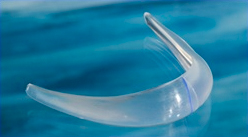 Extended anatomic chin implants are the most commonly used implant style today as they wrap around the sides of the chin to blend into the jawline for a smoother and more confluent augmented appearance. Chin implants come in tapered and square width designs, differing amounts of horizontal and vertical augmentations as well as combined chin-prejowl shapes. All of these chin implant designs help make the jawline stronger, give more chin projection and may help smooth out jowls and pick up some loose neck skin.
Extended anatomic chin implants are the most commonly used implant style today as they wrap around the sides of the chin to blend into the jawline for a smoother and more confluent augmented appearance. Chin implants come in tapered and square width designs, differing amounts of horizontal and vertical augmentations as well as combined chin-prejowl shapes. All of these chin implant designs help make the jawline stronger, give more chin projection and may help smooth out jowls and pick up some loose neck skin.
JAW ANGLE IMPLANTS
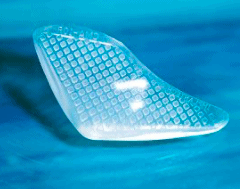
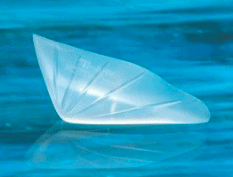 While augmenting the front part of the jaw has been around a long time, augmentation of the back part of the jaw (jaw angles) is a more recent facial implant innovation. To create stronger and more defined jaw angles, implants can be placed from inside the mouth that make it look wider, vertically longer or a combination of both. The two jaw angle implants styles are widening and vertical lengthening although each style does both but their dominant effect is indicated by their name. Lateral widening mandibular implants create the appearance of widened distance between mandibular angles on frontal view. Vertical lengthening mandibular implants drop the jaw angles down which will make for a more defined jaw angle appearance as well as decrease the mandibular plane angle.
While augmenting the front part of the jaw has been around a long time, augmentation of the back part of the jaw (jaw angles) is a more recent facial implant innovation. To create stronger and more defined jaw angles, implants can be placed from inside the mouth that make it look wider, vertically longer or a combination of both. The two jaw angle implants styles are widening and vertical lengthening although each style does both but their dominant effect is indicated by their name. Lateral widening mandibular implants create the appearance of widened distance between mandibular angles on frontal view. Vertical lengthening mandibular implants drop the jaw angles down which will make for a more defined jaw angle appearance as well as decrease the mandibular plane angle.
Jaw angle implants are often combined with chin implants to create an overall more complete jawline augmentation effect. While the implants don’t directly connect nor are they a substitute for a custom design jawline implant but in the properly selected patient it can be a success lower third of the face reshaping procedure.
CHEEK IMPLANTS
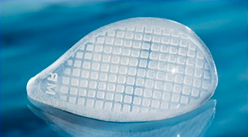 Cheek implants come in a wide variety of sizes and shapes to fill differing midface needs. The most common and historic use of cheek implants is to augment flat cheekbones or give cheekbones more prominence. This is the classic concept of cheek augmentation also known as malaria zone enhancement since they sit on largely on top of the zygoma or cheekbone.
Cheek implants come in a wide variety of sizes and shapes to fill differing midface needs. The most common and historic use of cheek implants is to augment flat cheekbones or give cheekbones more prominence. This is the classic concept of cheek augmentation also known as malaria zone enhancement since they sit on largely on top of the zygoma or cheekbone.
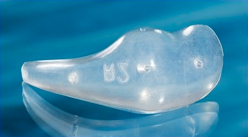 Cheek implants have also been developed to help lift tissue that have fallen off the cheekbones and fill in gaunt or sunken areas underneath the cheeks that have occurred due to fat loss from aging or certain medical conditions. These are known as submalar cheek implants as they partially add volume to the soft tissue area right underneath the cheekbone, creating a combined inferior cheekbone and soft tissue cheek augmentation effect.
Cheek implants have also been developed to help lift tissue that have fallen off the cheekbones and fill in gaunt or sunken areas underneath the cheeks that have occurred due to fat loss from aging or certain medical conditions. These are known as submalar cheek implants as they partially add volume to the soft tissue area right underneath the cheekbone, creating a combined inferior cheekbone and soft tissue cheek augmentation effect.
Malar and submalar cheek implants have also been combined to create a cheek implant style that combines both midfacial zones of augmentation. This is known as a malar shell implant or a combined malar-submalar implant. This type cheek implant produces the greatest amount of midface lift and volume augmentation.
TEAR TROUGH/INFRAORBITAL RIM IMPLANT
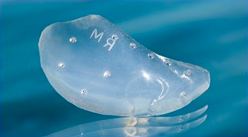 Grooves or indentations along the lower eyelid and cheek junction develop from either aging or from a natural orbital rim bony deficiency. They create ‘dark circles’ and a very visible depression under the eyes. While more commonly treated by synthetic injectable fillers or fat injections, implants have been developed to provide a permanent augmentation of the infraorbital rim from the more inner tear trough area out to the cheekbone. While most commonly called tear trough implants it is better to think of them as infraorbital rim implants of which the augmentation effect is primarily a horizontal one. Most infraorbital rims implants are placed through the lower eyelid, either an external transcutaneous or internal transconjunctival incision.
Grooves or indentations along the lower eyelid and cheek junction develop from either aging or from a natural orbital rim bony deficiency. They create ‘dark circles’ and a very visible depression under the eyes. While more commonly treated by synthetic injectable fillers or fat injections, implants have been developed to provide a permanent augmentation of the infraorbital rim from the more inner tear trough area out to the cheekbone. While most commonly called tear trough implants it is better to think of them as infraorbital rim implants of which the augmentation effect is primarily a horizontal one. Most infraorbital rims implants are placed through the lower eyelid, either an external transcutaneous or internal transconjunctival incision.
NASAL IMPLANT
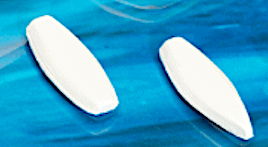 Building up a low or flat nasal bridge is most easily and commonly done around the w0rld with a nasal implant. When limited to the nasal dorsum (not the tip) and does not place too much stretch on the overlying nasal skin, it can have very successful results without long-term complications. The current preferred nasal implant is either an ePTFE -coated silicone or a full ePTFE composition.
Building up a low or flat nasal bridge is most easily and commonly done around the w0rld with a nasal implant. When limited to the nasal dorsum (not the tip) and does not place too much stretch on the overlying nasal skin, it can have very successful results without long-term complications. The current preferred nasal implant is either an ePTFE -coated silicone or a full ePTFE composition.
PARANASAL AND PREMAXILLARY IMPLANTS
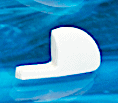
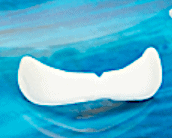 Building out the base of the nose is known as augmentation of the bony pyriform aperture. This is the bone area that surrounds the open nasal airway and extends from under the nose up along its sides to below the nasal bones. The paranasal area sits right under the nostril while the premaxillary area goes across the base of the nose. Facial implants exist for each of these areas or is combined into a single paranasal-premaxillary implant. (historically known as peri-pyriform implant)
Building out the base of the nose is known as augmentation of the bony pyriform aperture. This is the bone area that surrounds the open nasal airway and extends from under the nose up along its sides to below the nasal bones. The paranasal area sits right under the nostril while the premaxillary area goes across the base of the nose. Facial implants exist for each of these areas or is combined into a single paranasal-premaxillary implant. (historically known as peri-pyriform implant)
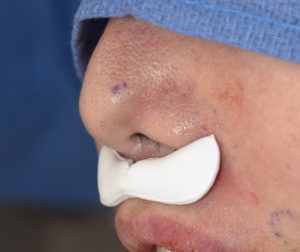 These implants are intended to push out the base of the nose and increased central midface projection. The preferred style of them today are pure ePTFE paranasal and premaxillary implants due to their improved shapes.
These implants are intended to push out the base of the nose and increased central midface projection. The preferred style of them today are pure ePTFE paranasal and premaxillary implants due to their improved shapes.
TEMPORAL IMPLANTS
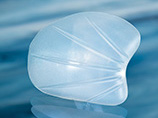
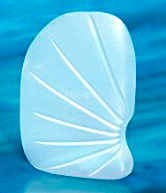 Due to the proliferation of the use of injectable fillers and fat, more permanent methods of temporal augmentation have been sought. The development of an ultrasoft temporal implant placed in the subfascial location on top of the muscle has proven to be both safe and effective. They are available in a standard temporal shell implant for Zone 1 augmentation (by the eye) and an extended temporal shell version (Zone 1 and 2) which addresses the temporal hollowing all the way up to the bony anterior temporal line of the forehead.
Due to the proliferation of the use of injectable fillers and fat, more permanent methods of temporal augmentation have been sought. The development of an ultrasoft temporal implant placed in the subfascial location on top of the muscle has proven to be both safe and effective. They are available in a standard temporal shell implant for Zone 1 augmentation (by the eye) and an extended temporal shell version (Zone 1 and 2) which addresses the temporal hollowing all the way up to the bony anterior temporal line of the forehead.
LIP IMPLANTS
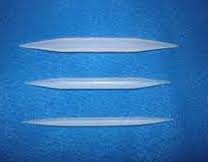 Augmentation of the lips is most commonly performed and maintained by various injectable materials. But when patients develop ‘filler fatigue’ the one permanent intralip volume augmentation method are lip implants. While lip implants have gone through a checkered history of using various materials, the Permalip implant offers the best material used to date. Made from an ultrasoft but solid silicone its tapered design allows for smooth placement and easy removal if necessary.
Augmentation of the lips is most commonly performed and maintained by various injectable materials. But when patients develop ‘filler fatigue’ the one permanent intralip volume augmentation method are lip implants. While lip implants have gone through a checkered history of using various materials, the Permalip implant offers the best material used to date. Made from an ultrasoft but solid silicone its tapered design allows for smooth placement and easy removal if necessary.
FOREHEAD IMPLANTS
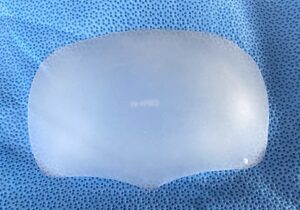 A new solid silicone implant is now available for forehead augmentation, specifically designed for females. (2023) Composed of a soft solid silicone material, it provides central forehead augmentation for an increased convex shape. Its greatest projection is in the center of the implant which gradually tapers down to paper thin edges at all of its perimeter edges. It has several thicknesses in which with increased thickness the footprint of the implant becomes greater. This prevents the augmentation effect from causing an undesired protrusive effect.
A new solid silicone implant is now available for forehead augmentation, specifically designed for females. (2023) Composed of a soft solid silicone material, it provides central forehead augmentation for an increased convex shape. Its greatest projection is in the center of the implant which gradually tapers down to paper thin edges at all of its perimeter edges. It has several thicknesses in which with increased thickness the footprint of the implant becomes greater. This prevents the augmentation effect from causing an undesired protrusive effect.
EAR IMPLANTS
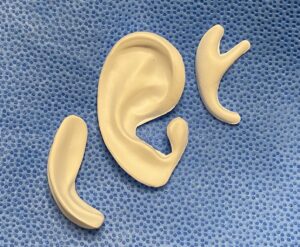 These innovative ear implants are made from a composite of an inner silicone core covered with expanded polytetrafluroethylene (ePTFE), both materials which have a long and successful history as a facial implant material. It is a softer and more flexible material, which maintains its shape, which having the feel more similar to that of the natural ear. This is unlike other ear implants made of harder plastic material which are rigid and and have limited flexibility.
These innovative ear implants are made from a composite of an inner silicone core covered with expanded polytetrafluroethylene (ePTFE), both materials which have a long and successful history as a facial implant material. It is a softer and more flexible material, which maintains its shape, which having the feel more similar to that of the natural ear. This is unlike other ear implants made of harder plastic material which are rigid and and have limited flexibility.
With its microporous structure the ePTFE coating allows soft tissue which aids implant stabilization to the side of the head. Such soft tissue ingrowth also optimizes the adaptation of the overlying skin to the various convexities and concavities of the implant’s framework which improves the external definition of the ear.
ePTFE ear implants come in with three components in various sizes which can be put together in large number of different ways to create the desired ear shape. The implants are also easily trimmed with a scalpel with a feel very similar to that of rib cartilage. They can be used as a stand alone ear reconstruction method or used t supplement a new or existing rib graft ear reconstruction.
Semi-Custom Facial Implants
zygomatic arch implant intraoperative fabtrication dr barry eppley IndianapolisWhile a large variety of preformed facial implants are available, not every desired facial augmentation need can be met by using them. For less common augmented facial areas, a more custom implant approach to the patient is needed. While it is always best to use a completely custom facial design of the desired shape and dimensions from the patient’s 3D CT scan, in certain circumstances a semi-custom implant approach can be used. A semi-custom approach means that the desired implant shape and thickness is hand carved in surgery from either an existing preformed facial implant or from a block of either solid silicone or ePTFE material. An example would be that of zygomatic arch implants to help make them more visible and add some width to the side of the face but not to the anterior cheek areas.
In addition to helping facial implant patients and providing custom facial implants when needed, Dr. Eppley performs an array of surgical and non-surgical procedures as well to help face lift, cheek implants and Botox patients.
Before Facial Implants
The specific facial areas to be improved are pointed out and discussed. Implants are particularly good at enhancing the cheek, chin, jaw angle, and nose. Implants are also frequently part of other facial procedures (e.g., rhinoplasty, facelift, etc.) as well. Often the patient does not recognize the value of implant enhancement in achieving their facial goals when considering other procedures. For this reason, computer imaging can be very helpful.
Facial Implants – The Operation
As an isolated procedure, facial implants under anesthesia as an outpatient. Most facial bone implants (e.g., cheeks chin, jaw angles) are placed either through incisions in the mouth or small skin incisions under the chin, at the lower eyelid or in the temporal hairline. When possible, the implant(s) will be secured to the bone with small screws to prevent postoperative shifting.
After Facial Implants
A lightly compressive facial dressing will be applied after surgery that can be removed the next day. Bruising is minimal but swelling will take several weeks to completely subside and see the approximate result. Judging the final effects of facial implants on the facial shape should not be done until three months after surgery.
Complications with facial implants are very infrequent. Despite being a foreign body, implants are well tolerated in facial areas and infection is extremely uncommon. Most facial implant problems are aesthetic in nature being that of positioning, symmetry or inadequate/excessive implant size.
Facial Implant Costs
- Chin implant $4,250
- Cheek implants $4,500 – $5,500
- Jaw Angle Implants $5,000 – $6,000
- Nose Implant (see Rhinoplasty costs)
- Temporal Implants $ 4,500
- Custom facial implants (see Custom Facial Implant costs)
(Fees are approximate)

North Meridian Medical Building
Address:
12188-A North Meridian St.
Suite 310
Carmel, IN 46032
Contact Us:
Phone: (317) 706-4444
WhatsApp: (317) 941-8237
